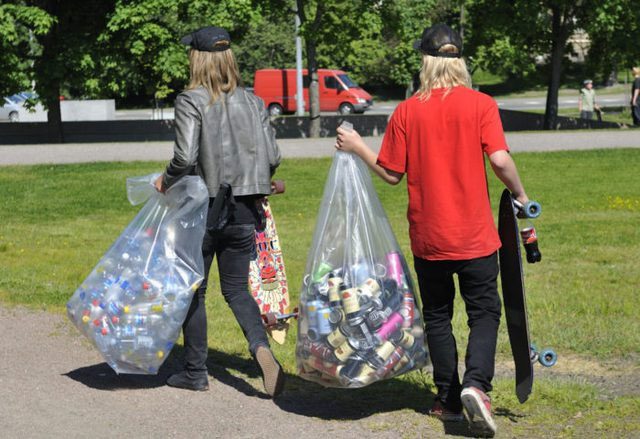Any bottle that someone accidentally leaves on the street or in a park is picked up by a Finnish resident and returned for the deposit money.
Despite being very busy, Quang Minh, who currently lives and works in Finland, manages to find time to clean his house to participate in the recycling program. After three months of collecting bottles at home, Minh received 4.65 euros for the bottles he returned. “The important thing is not how much money you get back, but this action is a necessary contribution to protecting the environment” – Minh stated.

In 1969, this discount store in Kouvola, southern Finland, advertised a two-cent return for each beer bottle. (Photo: Erkki Laitila / Lehtikuva)
When Bottles Become a “Link” in the Finnish Economy
It is known that the first bottle recycling programs began in the 1950s in this Nordic country, and today almost every bottle and can is recycled.
In 2020, Finnish citizens returned over 2 billion bottles and cans, accounting for 93% of total sales in Finland. Contributing factors include automated bottle return machines developed decades ago and the expansion of the system to include plastic bottles in the 2000s.
Across Finland, cans are returned at an average rate of 44 per second, plastic bottles at 17 per second, and glass bottles at four per second. The return rate in 2020 was 94% for aluminum cans (out of 1.4 billion sold), 92% for plastic bottles (out of 530 million), and 87% for glass bottles (out of 133 million). On average, each Finn returns 373 items in a year: 251 aluminum cans, 98 plastic bottles, and 24 glass bottles.
Recycling bottles and cans helps save energy and raw materials while reducing litter in cities and wilderness areas. Beverage containers become part of the circular economy when their materials are recycled into new containers or reused in other products.
Producing new cans from recycled aluminum requires only 5% of the energy used to make cans from scratch, and producing new glass from recycled glass consumes 30% less energy than making glass from scratch. (Statistics sourced from the website of Palpa, the non-profit organization managing Finland’s bottle recycling operations).

Common bottle and can collection scene in Finland. (Photo: Pekka Sakki/Lehtikuva)
How It Works
Today, there are nearly 5,000 container return machines across Finland. Most of them are located in supermarkets, gas stations, and beverage kiosks, making the return of containers a convenient part of daily life for residents. People simply place the bottles in the machine, which scans, sorts, and issues a receipt for the deposit refund. Hotels, restaurants, offices, schools, and event organizers return containers through their beverage suppliers.
Every time a person buys a drink in a bottle or can, they pay a deposit ranging from 15 to 40 cents. The system includes alcoholic beverages, soft drinks, and bottled water, in aluminum cans, glass bottles, and PET plastic bottles.
The bottle return machines are very user-friendly. You place the bottle or can on a small conveyor belt at the front of the machine. It passes through the scanner, and the machine sorts the bottles and crushes the cans. When finished, you press a button, and the machine provides you with a receipt. Plastic bottles are valued at 20 to 40 cents depending on their size, while glass bottles are valued at 10 to 40 cents, and aluminum cans are valued at 15 cents. Returned containers are recycled or their materials are reused.
This money is exchanged for a voucher-like receipt that can be scanned for a discount or redeemed for cash at the supermarket. When you present the receipt to the cashier, they will either give you cash back or deduct the deposit refund from your purchase. Some machines also offer the option to donate the refund to charity.


















































